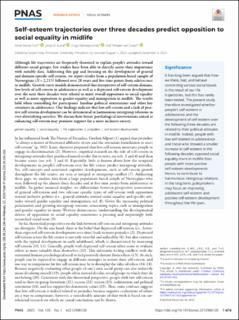| dc.contributor.author | Fluit, Anne-Marie | |
| dc.contributor.author | Kunst, Jonas R. | |
| dc.contributor.author | Bierwiaczonek, Kinga | |
| dc.contributor.author | von Soest, Tilmann | |
| dc.date.accessioned | 2024-02-14T11:29:56Z | |
| dc.date.available | 2024-02-14T11:29:56Z | |
| dc.date.created | 2023-01-01T12:51:26Z | |
| dc.date.issued | 2023 | |
| dc.identifier.citation | Proceedings of the National Academy of Sciences of the United States of America. 2023, 120 (1), . | en_US |
| dc.identifier.issn | 0027-8424 | |
| dc.identifier.uri | https://hdl.handle.net/11250/3117484 | |
| dc.description.abstract | Although life trajectories are frequently theorized to explain people’s attitudes toward different social groups, few studies have been able to directly assess their importance with suitable data. Addressing this gap and focusing on the development of general and domain-specific self-esteem, we report results from a population-based sample of Norwegians (N = 2,215) followed over 28 years and five time points from adolescence to midlife. Growth curve models demonstrated that irrespective of self-esteem domain, low levels of self-esteem in adolescence as well as a depressed self-esteem development over the next three decades were related to more overall opposition to social equality as well as more opposition to gender equality and immigration in midlife. The results held when controlling for participants’ baseline political orientations and other key covariates in adolescence. Our findings indicate that low self-esteem and a lack of posi- tive self-esteem development can be detrimental to harmonious intergroup relations in ever-diversifying societies. We discuss how future psychological interventions aimed at enhancing self-esteem may promote support for a more inclusive society. | en_US |
| dc.language.iso | eng | en_US |
| dc.rights | Attribution-NonCommercial-NoDerivatives 4.0 Internasjonal | * |
| dc.rights.uri | http://creativecommons.org/licenses/by-nc-nd/4.0/deed.no | * |
| dc.title | Self-esteem trajectories over three decades predict opposition to social equality in midlife | en_US |
| dc.type | Peer reviewed | en_US |
| dc.type | Journal article | en_US |
| dc.description.version | publishedVersion | en_US |
| cristin.ispublished | true | |
| cristin.fulltext | original | |
| cristin.qualitycode | 2 | |
| dc.identifier.doi | 10.1073/pnas.2212906120 | |
| dc.identifier.cristin | 2098455 | |
| dc.source.journal | Proceedings of the National Academy of Sciences of the United States of America | en_US |
| dc.source.volume | 120 | en_US |
| dc.source.issue | 1 | en_US |
| dc.source.pagenumber | 6 | en_US |
| dc.relation.project | Norges forskningsråd: 288083 | en_US |
| dc.relation.project | Norges forskningsråd: 301010 | en_US |

